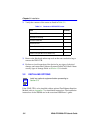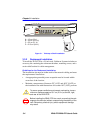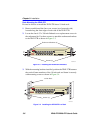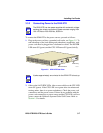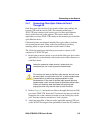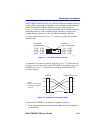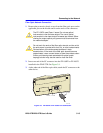
Connecting to the Network
2E48-27R/2E49-27R User’s Guide 3-9
3.4.1 Connecting Fiber Optic Cables to Ports 1
Through 24
Each fiber optic link consists of two strands of fiber optic cabling: the
transmit (TX) and the receive (RX). The transmit strand from a
2E4X-27R port connects to the receive port of a fiber optic Ethernet
device at the other end of the segment. The receive strand of the
applicable port on the 2E4X-27R connects to the transmit port of the fiber
optic Ethernet device.
Cabletron Systems recommends labeling fiber optic cables to indicate
receive and transmit ends. Many cables are prelabeled, providing
matching labels or tapes at both ends of each strand of cable.
The following instructions detail the process used to connect an ST
connector to a 2E4X-27R port.
1. Remove the protective plastic covers from the fiber optic ports on the
applicable port on the module, and from the ends of the connectors on
each fiber strand.
2. Refer to Figure 3-6 and attach one fiber to the applicable receive (RX)
port on the 2E4X-27R. Insert the ST connector into the port with the
alignment slot on the connector inserted over the locking key on the
port. Turn the connector clockwise to lock it in place.
3. Attach the other fiber of the pair to the applicable transmit (TX) port
on the 2E4X-27R using the same procedure to insert the ST connector.
NOTE
Leave the protective rubber covers in place when the
connectors are not in use to prevent contamination.
!
CAUTION
Do not touch the ends of the fiber optic strands, and do not let
the ends come in contact with dust, dirt, or other contaminants.
Contamination of cable ends causes problems in data
transmissions. If the ends of the fiber optic strands become
contaminated, use a canned duster to blow the surfaces clean.
A fiber port cleaning swab saturated with optical-grade
isopropyl alcohol may also be used to clean the ends.




